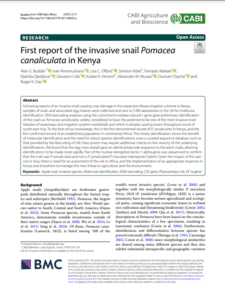First report of the invasive snail Pomacea canaliculata in Kenya
Published: March, 2021
Journal article
Following reports of an invasive snail causing crop damage in the expansive Mwea irrigation scheme in Kenya, samples of snails and associated egg masses were collected and sent to CABI laboratories in the UK for molecular identification. DNA barcoding analyses using the cytochrome oxidase subunit I gene gave preliminary identification of the snails as Pomacea canaliculata, widely considered to have the potential to be one of the most invasive invertebrates of waterways and irrigation systems worldwide and which is already causing issues throughout much of south-east Asia. To the best of our knowledge, this is the first documented record of P. canaliculata in Kenya, and the first confirmed record of an established population in continental Africa. This timely identification shows the benefit of molecular identification and the need for robust species identifications: even a curated sequence database such as that provided by the Barcoding of Life Data system may require additional checks on the veracity of the underlying identifications. We found that the egg mass tested gave an identical barcode sequence to the adult snails, allowing identifications to be made more rapidly. Part of the nuclear elongation factor 1 alpha gene was sequenced to confirm that the snail was P. canaliculata and not a P. canaliculata/P. maculata interspecies hybrid. Given the impact of this species in Asia, there is need for an assessment of the risk to Africa, and the implementation of an appropriate response in Kenya and elsewhere to manage this new threat to agriculture and the environment.

First report of the invasive snail Pomacea canaliculata in Kenya
DOI https://doi.org/10.1186/s43170-021-00032-z
Type Journal article
Published in CABI Agriculture and Bioscience, 2(11)
Language English
Year 2021
Related projects
Action on Invasives
The global cost of invasive species is estimated at US$1.4 trillion per year – close to 5% of global gross domestic product. Invasives disproportionately affect vulnerable communities in poor rural areas, especially in developing countries which depend on natural resources, healthy ecosystems, trade and tourism for their livelihoods.
Start: 02/01/18 -End: 31/03/21
